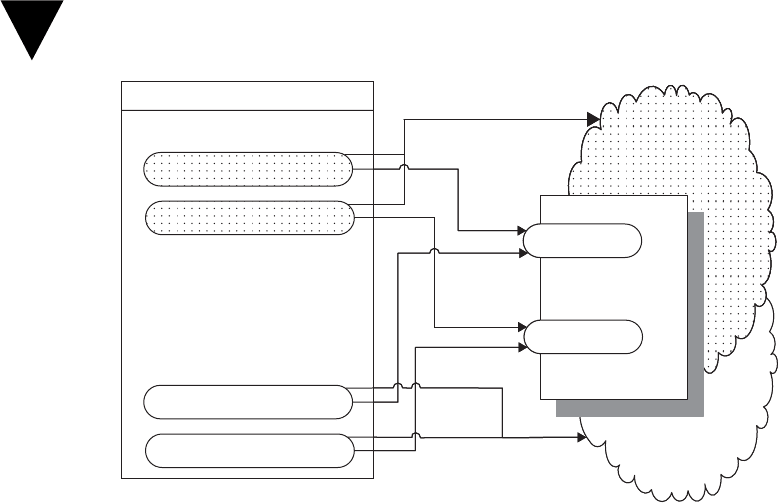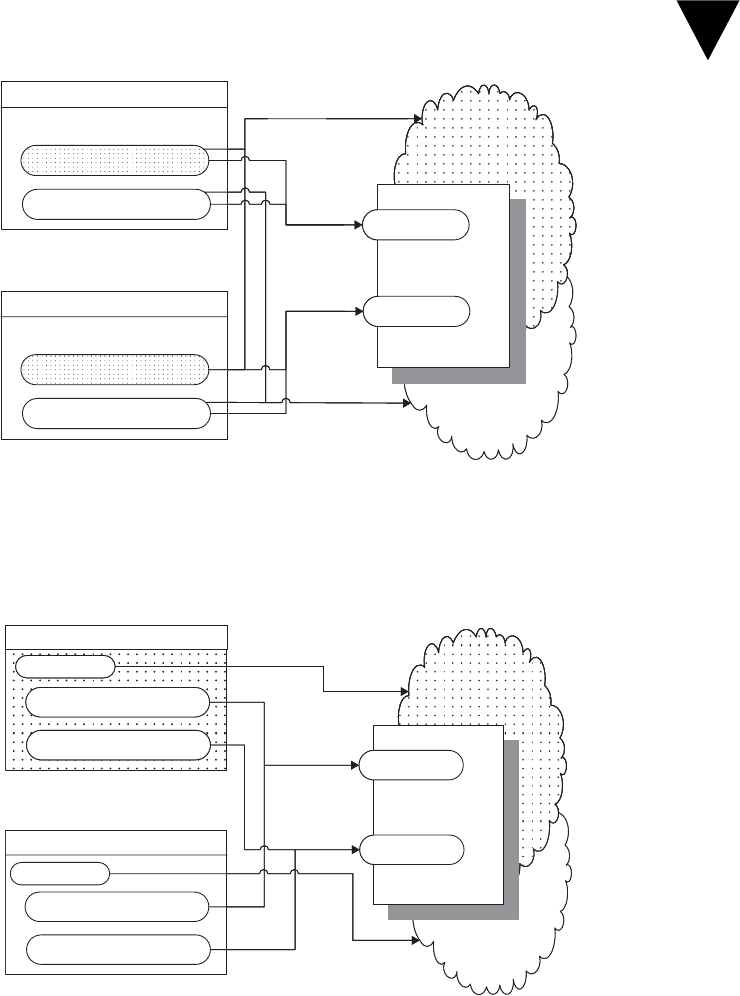Meszaros G. xUnit Test Patterns Refactoring Test Code
Подождите немного. Документ загружается.


148
Chapter 11 Using Test Doubles
Other Ways of Retrofi tting Testability
All is not lost when none of the techniques described thus far can be used to
introduce testability. We still have a few tricks left up our sleeves.
Test Hooks are the “elephant in the room” that no one wants to talk about
because they may lead to Test Logic in Production. Test Hooks, however, are
a perfectly legitimate way to get legacy code under test when it is too hard or
dangerous to introduce one of the techniques described earlier. They are best
used as a “transition” strategy to allow Scripted Tests (page 285) or Recorded
Tests (page 278) to be automated to provide a Safety Net (see page 24) while
large-scale refactoring is undertaken to improve testability. Ideally, once the
code has been made more testable, better tests can be prepared using the tech-
niques described earlier and the Test Hooks can be removed.
Michael Feathers [WEwLC] has described several other techniques to
replace dependencies with test-specifi c code under the general heading of fi nd-
ing “object seams.” For example, we can replace a depended-on library with
a library designed specifi cally for testing. A seemingly hard-coded dependency
can be broken this way. Most of these techniques are less applicable when we
need to dynamically replace dependencies within individual tests than either
Dependency Injection or Dependency Lookup because they require changes to
the environment. Object seams are, however, an excellent way to place legacy
code under test so that it can be refactored to introduce either of the previously
mentioned dependency-breaking techniques.
We can use aspect-oriented programming (AOP) to install the Test
Double behavior by defi ning a test point-cut that matches the place where
the SUT calls the DOC and we would rather have it call the Test Double.
Although we need an AOP-enabled development environment to do this, we
do not need to deploy the AOP-generated code into a production environ-
ment. As a consequence, this technique may be used even in AOP-hostile
environments.
Other Uses of Test Doubles
So far, we have covered the testing of indirect inputs and indirect outputs. Now
let’s look at some other uses of Test Doubles.

149
Endoscopic Testing
Tim Mackinnon et al. introduced the concept of endoscopic testing [ET] in their
initial Mock Objects paper. Endoscopic testing focuses on testing the SUT from
the inside by passing in a Mock Object as an argument to the method under test.
This allows verifi cation of certain internal behaviors of the SUT that may not
always be visible from the outside.
The classic example that Mackinnon and colleagues cite is the use of a mock
collection class preloaded with all of the expected members of the collection.
When the SUT tries to add an unexpected member, the mock collection’s asser-
tion fails. The full stack trace of the internal call stack then becomes visible in
the xUnit failure report. If our IDE supports breaking on specifi ed exceptions,
we can also inspect the local variables at the point of failure.
Need-Driven Development
A refi nement of endoscopic testing is “need-driven development” [MRNO], in
which the dependencies of the SUT are defi ned as the tests are written. This
“outside-in” approach to writing and testing software combines the conceptual
elegance of the traditional “top-down” approach to writing code with modern
TDD techniques supported by Mock Objects. It allows us to build and test the
software layer by layer, starting at the outermost layer before we have imple-
mented the lower layers.
Need-driven development combines the benefi ts of test-driven development
(specifying all software with tests before we build them) with a highly incre-
mental approach to design that removes the need for any speculation about
how a depended-on class might be used.
Speeding Up Fixture Setup
Another application of Test Doubles is to reduce the runtime cost of Fresh Fix-
ture (page 311) setup. When the SUT needs to interact with other objects that
are diffi cult to create because they have many dependencies, a single Test Dou-
ble can be created instead of the complex network of objects. When applied to
networks of entity objects, this technique is called Entity Chain Snipping (see
Test Stub).
Other Uses of Test Doubles

150
Chapter 11 Using Test Doubles
Speeding Up Test Execution
Test Doubles may also be used to speed up tests by replacing slow compo-
nents with faster ones. Replacing a relational database with an in-memory Fake
Object, for example, can reduce test execution times by an order of magnitude!
The extra effort required to code the Fake Database is more than offset by the re-
duced waiting time and the quality improvement due to the more timely feedback
that comes from running the tests more frequently. Refer to the sidebar “Faster
Tests without Shared Fixtures” on page 319 for a more detailed discussion of
this issue.
Other Considerations
Because many of our tests will involve replacing a real DOC with a Test
Double, how do we know that the production code will work properly when
it uses the real DOC? Of course, we would expect our customer tests to verify
behavior with the real DOCs in place (except, possibly, when the real DOCs are
interfaces to other systems that need to be stubbed out during single-system
testing). We should write a special form of Constructor Test (see Test Method)—
a “substitutable initialization test”—to verify that the real DOC is installed
properly. The trigger for writing this test is performing the fi rst test that
replaces the DOC with a Test Double—that point is often when the Test
Double installation mechanism is introduced.
Finally, we want to be careful that we don’t fall into the “new hammer
trap.”
6
Overuse of Test Doubles (and especially Mock Objects or Test Stubs) can
lead to Overspecifi ed Software (see Fragile Test on page 239) by encoding
implementation-specifi c information about the design in our tests. The design
may be then much more diffi cult to change if many tests are affected by the
change simply because they use a Test Double that has been affected by the
design change.
6
“When you have a new hammer, everything looks like a nail.”

151
What’s Next?
In this chapter, we examined techniques for testing software with indirect inputs
and indirect outputs. In particular, we explored the concept of Test Doubles
and various techniques for installing them. In Chapter 12, Organizing Our
Tests, we will turn our attention to strategies for organizing the test code into
Test Methods and Test Utility Methods (page 599) implemented on Testcase
Classes (page 373) and Test Helpers (page 643).
What’s Next?
This page intentionally left blank

153
Chapter 12
Organizing Our Tests
About This Chapter
In the chapters concluding with Chapter 11, Using Test Doubles, we looked at
various techniques for interacting with the SUT for the purpose of verifying its
behavior. In this chapter, we turn our attention to the question of how to orga-
nize the test code to make it easy to fi nd and understand.
The basic unit of test code organization is the Test Method (page 348).
Deciding what to put in the Test Method and where to put it is central to the topic
of test organization. When we have only a few tests, how we organize them isn’t
terribly important. By contrast, when we have hundreds of tests, test organization
becomes a critical factor in keeping our tests easy to understand and fi nd.
This chapter begins by discussing what we should and should not include in
a Test Method. Next, it explores how we can decide on which Testcase Classes
(page 373) to put our Test Methods. Test naming depends heavily on how we
have organized our tests, so we will talk about this issue next. We will then
consider how to organize the Testcase Classes into test suites and where to put
test code. The fi nal topic is test code reuse—specifi cally, where to put reusable
test code.
Basic xUnit Mechanisms
The xUnit family of Test Automation Frameworks (page 298) provides a num-
ber of features to help us organize our tests. The basic question, “Where do I
code my tests?”, is answered by putting our test code into a Test Method on a
Testcase Class. We then use either Test Discovery (page 393) or Test Enumera-
tion (page 399) to create a Test Suite Object (page 387) containing all the tests
from the Testcase Class. The Test Runner (page 377) invokes a method on the
Test Suite Object to run all the Test Methods.

154
Chapter 12 Organizing Our Tests
Right-Sizing Test Methods
A test condition is something we need to prove the SUT really does; it can be
described in terms of what the starting state of the SUT is, how we exercise the
SUT, how we expect the SUT to respond, and what the ending state of the SUT
is expected to be. A Test Method is a sequence of statements in our test scripting
language that exercises one or more test conditions (Figure 12.1). What should
we include in a single Test Method?
Figure 12.1 The four phases of a typical test. Each Test Method implements a
Four-Phase Test (page 358) that ideally verifi es a single test condition. Not all
phases of the Four-Phase Test need be in the Test Method.
Many xUnit purists prefer to Verify One Condition per Test (see page 45)
because it gives them good Defect Localization (see page 22). That is, when a
test fails, they know exactly what is wrong in the SUT because each test verifi es
exactly one test condition. This is very much in contrast with manual testing,
where one tends to build long, involved multiple-condition tests because of the
overhead involved in setting up each test’s pre-conditions. When creating xUnit-
based automated tests, we have many ways of dealing with this frequently re-
peated fi xture setup (as described in Chapter 8, Transient Fixture Management),
so we tend to Verify One Condition per Test. We call a test that verifi es too many
test conditions an Eager Test (see Assertion Roulette on page 224) and consider
it a code smell.
A test that verifi es a single test condition executes a single code path through
the SUT and it should execute exactly the same path each time it runs; that
is what makes it a Repeatable Test (see page 26). Yes, that means we need as
Testcase
Class
Create
Testcase
Object
testMethod_n
Testcase
Object
testMethod_1
testMethod_1
testMethod_n
Test
Suite
Object
Exercise
Create
Exercise
Create
Fixture
SUT
Run
Suite
Test Runner
Setup
Exercise
Verify
Teardown
Testcase
Class
Create
Testcase
Object
testMethod_n
Testcase
Object
testMethod_1
testMethod_1
testMethod_n
Test
Suite
Object
Exercise
Create
Exercise
Create
Fixture
SUT
Run
Suite
Test Runner
Setup
Exercise
Verify
Teardown

155
many test methods as we have paths through the code—but how else can we
expect to achieve full code coverage? What makes this pattern manageable is
that we Isolate the SUT (see page 43) when we write unit tests for each class so
we only have to focus on paths through a single object. Also, because each test
should verify only a single path through the code, each test method should con-
sist of strictly sequential statements that describe what should happen on that
one path.
1
Another reason we Verify One Condition per Test (see page 45) is to
Minimize Test Overlap (see page 44) so that we have fewer tests to modify if we
later modify the behavior of the SUT.
Brian Marrick has developed an interesting compromise that I call “While
We’re at It,”
2
which leverages the test fi xture we already have set up to run
some additional checks and assertions. Marrick clearly marks these elements
with comments to indicate that if changes to the SUT obsolete that part of the
test, they can be easily deleted. This strategy minimizes the effort needed to
maintain the extra test code.
Test Methods and Testcase Classes
A Test Method needs to live on a Testcase Class. Should we put all our Test
Methods onto a single Testcase Class for the application? Or should we create a
Testcase Class for each Test Method? Of course, the right answer lies somewhere
between these two extremes, and it will change over the life of our project.
Testcase Class per Class
When we write our fi rst few Test Methods, we can put them all onto a single
Testcase Class. As the number of Test Methods increases, we will likely want to
split the Testcase Class so that one Testcase Class per Class (page 617) is tested,
which reduces the number of Test Methods per class (Figure 12.2). As those
Testcase Classes get too big, we usually split the classes further. In that case, we
need to decide which Test Methods to include in each Testcase Class.
1
A Test Method that contains Conditional Test Logic (page 200) is a sign of a test trying
to accommodate different circumstances because it does not have control of all indirect
inputs of the SUT or because it is trying to verify complex expected states on an in-line
basis within the Test Method.
2
He calls it “Just for Laughs” but I don’t fi nd that name very intent-revealing.
Test Methods and Testcase Classes

156
Chapter 12 Organizing Our Tests
Figure 12.2 A production class with a single Testcase Class. With the Testcase
Class per Class pattern, a single Testcase Class holds all the Test Methods for
all the behavior of our SUT class. Each Test Method may need to create a
different fi xture either in-line or by delegating that task to a Creation Method
(page 415).
Testcase Class per Feature
One school of thought is to put all Test Methods that verify a particular feature of
the SUT—where a “feature” is defi ned as one or more methods and attributes that
collectively implement some capability of the SUT—into a single Testcase Class
(Figure 12.3). This makes it easy to see all test conditions for that feature. (Use of
appropriate Test Naming Conventions helps achieve this clarity.) It can, however,
result in similar fi xture setup code being required in each Testcase Class.
Testcase Class per Fixture
The opposing view is that one should group all Test Methods that require the same
test fi xture (same pre-conditions) into one Testcase Class per Fixture (page 631; see
Figure 12.4). This facilitates putting the test fi xture setup code into the setUp method
(Implicit Setup; see page 424) but can result in scattering of the test conditions for
each feature across many Testcase Classes.
TestcaseClass
Fixture B
Fixture A
SUT Class
testMethod_B_1
testMethod_B_2
testMethod_A_1
testMethod_A_2
feature_1
feature_2
Exercise
Exercise
Creation
Creation
TestcaseClass
Fixture B
Fixture A
SUT Class
testMethod_B_1
testMethod_B_2
testMethod_A_1
testMethod_A_2
feature_1
feature_2
Exercise
Exercise
Creation
Creation

157
Figure 12.3 A production class with one Testcase Class for each feature. With
the Testcase Class per Feature pattern, we have one Testcase Class for each
major capability or feature supported by our SUT class. The Test Methods on
that test class exercise various aspects of that feature after building whatever test
fi xture they require.
Figure 12.4 A production class with one Testcase Class for each fi xture. With
the Testcase Class per Fixture pattern, we have one Testcase Class for each
possible test fi xture (test pre-condition) of our SUT class. The Test Methods on
that test class exercise various features from the common starting point.
Fixture B
Fixture A
SUT Class
Feature2TestcaseClass
testMethod_A
testMethod_B
Feature1TestcaseClass
testMethod_A
testMethod_B
Creation
feature_1
feature_2
Creation
Exercise
Exercise
Fixture B
Fixture A
SUT Class
Feature2TestcaseClass
testMethod_A
testMethod_B
Feature1TestcaseClass
testMethod_A
testMethod_B
Creation
feature_1
feature_2
Creation
Exercise
Exercise
Fixture B
Fixture A
SUT Class
FixtureBTestcaseClass
testMethod_1
testMethod_2
FixtureATestcaseClass
testMethod_2
setUp
setUp
feature_1
feature_2
Creation
Creation
Exercise
Exercise
FixtureATestcaseClass
testMethod_1
Fixture B
Fixture A
SUT Class
FixtureBTestcaseClass
testMethod_1
testMethod_2
FixtureATestcaseClass
testMethod_2
setUp
setUp
feature_1
feature_2
Creation
Creation
Exercise
Exercise
FixtureATestcaseClass
testMethod_1
Test Methods and Testcase Classes
